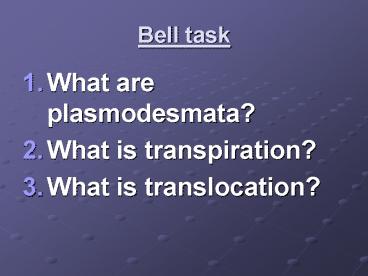Bell task - PowerPoint PPT Presentation
1 / 12
Title:
Bell task
Description:
Know the arrangement of Xylem and Phloem vessels in the roots and leaves, and ... parts of xylem and phloem on diagrams. Understand how xylem vessels are formed ... – PowerPoint PPT presentation
Number of Views:62
Avg rating:3.0/5.0
Title: Bell task
1
Bell task
- What are plasmodesmata?
- What is transpiration?
- What is translocation?
2
Starter answer the following questions -
sentences
- Which tubes carry water in plants?
- Which tubes carry sucrose in plants?
- Draw a diagram of the arrangement of these tubes
in the stem of a plant. (p134) - Explain why they are arranged in this way.
- Draw a diagram of the arrangement of these tubes
in the leaves of plants. (p134) - Explain why they are arranged in this way.
- Draw a diagram of the arrangement of these
vessels in the root of the plant. (p131) - Give a reason for this arrangement.
3
- Which tubes carry water in plants? Xylem
- Which tubes carry sucrose in plants? Phloem
- Stem Explain why they are arranged in this way.
- Reduce water loss through stem
- LeavesExplain why they are arranged in this way.
- Reduce water loss through leaf
- RootGive a reason for this arrangement.
- Move water away from root hair to preserve water
potential gradient
4
Lesson objectives
- Know the functions of xylem and phloem tissues
- Know the arrangement of Xylem and Phloem vessels
in the roots and leaves, and the reasons for them - Be able to Identify the key parts of xylem and
phloem on diagrams - Understand how xylem vessels are formed
5
Using Fg10.7 P133 and Fig 10.15 p140 answer the
following questions
- Which type of vessel have organelles?
- Which organelles are missing from the vessel?
- Are a) xylem and b) phloem alive or dead? Explain
your answer
6
- Which type of vessel have organelles?
- Phloem
- Which organelles are missing from the vessel?
- Nucleus RER/ribosomes vacuole (tonoplast)
- Are a) xylem and b) phloem alive or dead? Explain
your answer - Dead nothing in them to maintain life
- Alive however cannot survive without companion
cells
7
Xylem formation Quick study
- A series of normal plant cells (end to end)
- Lignin deposits in the cell walls (impermeable
and waterproof) continues through time - Pits form where no lignin is laid due to
plasmodesmata - Due to lack of essential substances, contents of
the cell die - End sections of the cells break down, causing a
tube like structure to form - Normally a tube like this would collapse in on
itself, however the lignin gives support which
prevents this
8
Spend 5 minutes adding to your notes on Xylem
page 133/4
It is obvious who is showing commitment to their
studies
9
Phloem quick study
- Living cells which are lined up end to end
(called sieve elements) - Small pores/gaps in the end parts of the cells
which allow substances to pass through (sieve
plates) - Very small amount of cytoplasm arranged around
the edge of the cell - No nucleus or ribosomes (no protein synthesis)
- Companion cells lined up alongside sieve elements
and are linked/connected to them. These cells
provide the things that the sieve element cannot
provide for themselves (many mitochondria and
ribosomes)
10
Spend 5 minutes adding to your notes on Phloem
Page 140
11
Lesson objectives have we met them????????
- Know the functions of xylem and phloem tissues
- Know the arrangement of Xylem and Phloem vessels
in the roots and leaves, and the reasons for them - Be able to Identify the key parts of xylem and
phloem on diagrams - Understand how xylem vessels are formed
12
Plenary link the structure to the description
Living cells which have no nucleus or ribosomes,
whose cell walls develop gaps/pores in their ends
Xylem
Closely associated with another cell, death
usually leads to death of associated cell Dense
cytoplasm with the usual organelles. Metabolically
very active
Sieve tube element
Elongated and lignified dead cells with empty
lumens. Formed by fusion of many cells
Companion cell































